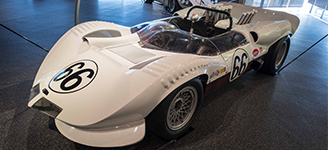Chaparral 2J
 As different as it appears, this angular, boxy car built for the 1970 Can-Am series was designed to create immense down force independent of speed. With two 17-inch fans driven by a 2nd engine at the rear of the car, the 2J earned the nickname “sucker car” as it literally sucked air from under the car and forced it out the back, thus creating a vacuum that held the 2J on the track surface. This down force increased grip to the tires independently of the car’s forward motion, and allowed the car to corner faster in both slow and high speed turns. To create a seal between the car and the road, sliding polycarbonate skirts were placed around the bottom edge of the car and maintained a constant gap to the ground. Theoretically, enough suction could be generated by the fans to hold the car upside-down on the ceiling of a room. The airflow generated by the fans alone could push the car forward at up to 40 miles per hour.
As different as it appears, this angular, boxy car built for the 1970 Can-Am series was designed to create immense down force independent of speed. With two 17-inch fans driven by a 2nd engine at the rear of the car, the 2J earned the nickname “sucker car” as it literally sucked air from under the car and forced it out the back, thus creating a vacuum that held the 2J on the track surface. This down force increased grip to the tires independently of the car’s forward motion, and allowed the car to corner faster in both slow and high speed turns. To create a seal between the car and the road, sliding polycarbonate skirts were placed around the bottom edge of the car and maintained a constant gap to the ground. Theoretically, enough suction could be generated by the fans to hold the car upside-down on the ceiling of a room. The airflow generated by the fans alone could push the car forward at up to 40 miles per hour.
In its first race, the 2J recorded the fastest lap at Watkins Glen, New York and then earned the pole position in all its other races. In fact it was so fast that the FIA officials banned the 2J at the end of the 1970 Can-Am season because the sliding polycarbonate skirts were said to have violated the “movable aerodynamic device” ban; thus ending the car’s career at its Dawn of Victory.
“If I can come up with a better mousetrap that is within the regulations, I ought to be allowed to use it.”
-Jim Hall, October, 1970, as momentum gathered to ban the 2J “sucker” car.
Engine: Chevrolet aluminum big-block 465-cubic-inch V-8
Horsepower: 680 at 7,000 rpm
Carburetion: Chaparral crossover manifold with Lucas fuel injection
Transmission: 3-speed Chaparral “automatic”
Bodywork: Fiberglass front bodywork; aluminum and fiberglass composite rear bodywork
Cooling: Front-mounted radiator; oil cooler mounted behind radiator
Aerodynamics: Rockwell two-stroke two cylinder 55-bhp engine driving two 17-inch axial-flow fans; articulated skirts made of .09 inch polycarbonate sheets to seal undercar pressure area; radiator tunnel at front and adjustable rear flap to help balance down force on body
Chassis: Aluminum semi-monocoque with engine cantilevered from rear bulkhead
Wheels: Chaparral spoked single-piece cast magnesium; 15-inch diameter with six-bolt mounting
Tires: Front 13.9 x 15, rear 17.0 x 15, Firestone
Brakes: 12 inch ventilated discs, Airheart calipers
Suspension: Front: tubular double wishbones with coil-over shock absorbers, anti-roll bar; Rear: anti-squat twin trailing arms, reverse lower A-arms, single top links, coil-over shock absorbers, anti-roll bar
Dimensions: 95-inch wheelbase, 145-inch length, 78-inch width, 60-inch front track, 55-inch rear track, 4-inch static ground clearance
Average Weight: 2,030 pounds, dry




